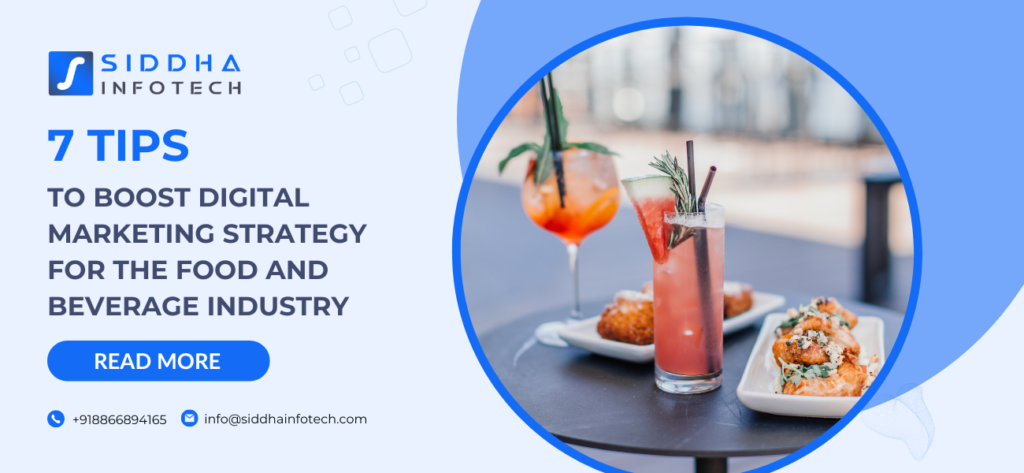9 Tips to Improve Digital Marketing for Finance Agency
In the ever-evolving digital marketing strategy for the food and beverage industry faces unique challenges and opportunities. To stay competitive and attract more customers, businesses in this sector must adopt effective digital marketing strategies. Siddha Infotech has compiled seven essential tips to help you improve your digital marketing efforts and achieve your business goals. For effective digital marketing in the food and beverage industry, leveraging digital marketing for food and beverage strategies is crucial. Businesses should focus on building a strong brand identity, optimizing their website for user experience, and leveraging social media platforms to engage with their audience. Additionally, implementing email marketing campaigns, investing in content marketing, utilizing local SEO, and continuously analyzing and adapting strategies are essential steps to boost online presence and drive customer engagement. By following these tips, food and beverage businesses can improve their digital marketing efforts and achieve long-term success.
1. Develop a Strong Brand Identity
A strong brand identity is crucial for standing out in the crowded food and beverage market. Your brand identity should reflect your values, mission, and the unique qualities of your products. Here are some steps to build a compelling brand identity:
Define Your Brand Values
Identify the core values that your brand represents. These values should resonate with your target audience and set you apart from competitors.
Create a Memorable Logo and Tagline
Design a logo that is visually appealing and easy to recognize. Pair it with a catchy tagline that encapsulates your brand's essence.
Consistent Branding Across All Channels
Ensure that your branding is consistent across all digital channels, including your website, social media profiles, and email marketing. Consistency builds trust and recognition.
Tell Your Brand Story
Share the story behind your brand. Whether it's the inspiration behind your recipes or the journey of your founders, a compelling narrative can create an emotional connection with your audience.
2. Optimize Your Website for User Experience
Your website is often the first point of contact between your brand and potential customers. A well-optimized website can significantly impact user experience and conversion rates. Here’s how to optimize your website:
Mobile-Friendly Design
With a significant portion of web traffic coming from mobile devices, it's essential to have a responsive website design that looks and functions well on all screen sizes.
Fast Loading Speeds
Website loading speed is critical for user satisfaction and SEO rankings. Use tools like Google PageSpeed Insights to identify and fix any issues slowing down your site.
Easy Navigation
Ensure your website is easy to navigate with clear menus, search functionality, and well-organized content. Users should be able to find what they’re looking for quickly.
High-Quality Visuals
Use high-quality images and videos to showcase your products. Visual content can capture attention and provide a better understanding of what you offer.
Clear Calls to Action (CTAs)
Incorporate clear and compelling CTAs throughout your website to guide users towards desired actions, such as making a purchase or signing up for a newsletter.
3. Leverage Social Media Marketing
Social media platforms are powerful tools for engaging with your audience and promoting your food and beverage products. Here are some tips for effective social media marketing:
Choose the Right Platforms
Identify the social media platforms where your target audience is most active. For the food and beverage industry, Instagram, Facebook, and Pinterest are particularly effective.
Post High-Quality Content Regularly
Share a mix of content, including photos, videos, recipes, behind-the-scenes looks, and customer testimonials. High-quality visuals and engaging captions are key.
Engage with Your Audience
Respond to comments and messages promptly. Engaging with your audience builds community and fosters loyalty.
Run Social Media Campaigns
Use social media campaigns to promote new products, special offers, or events. Consider using paid advertising to reach a broader audience.
Collaborate with Influencers
Partner with food bloggers and influencers to expand your reach and credibility. Influencer endorsements can significantly impact consumer decisions.
4. Implement Email Marketing
Email marketing remains a highly effective way to reach and engage your customers. Here’s how to create successful email marketing campaigns:
Build an Email List
Collect email addresses through sign-up forms on your website, social media, and in-store. Offer incentives like discounts or free recipes to encourage sign-ups.
Segment Your Audience
Segment your email list based on customer preferences, purchase history, and demographics. This allows you to send personalized and relevant content.
Create Compelling Content
Craft engaging email content that includes product updates, special offers, recipes, and tips. Use attention-grabbing subject lines to increase open rates.
Use Automation
Set up automated email campaigns for welcome messages, abandoned cart reminders, and post-purchase follow-ups. Automation saves time and ensures timely communication.
Analyze and Optimize
Track the performance of your email campaigns using metrics like open rates, click-through rates, and conversions. Use this data to refine your strategies.
5. Invest in Content Marketing
Content marketing is a powerful way to attract, engage, and retain customers by providing valuable information. Here’s how to leverage content marketing:
Start a Blog
Create a blog on your website where you can share recipes, cooking tips, industry news, and behind-the-scenes stories. Regularly updated blogs improve SEO and drive traffic.
Use Visual Content
Incorporate images, videos, and infographics in your content to make it more engaging and shareable. Visual content is particularly effective in the food and beverage industry.
Optimize for SEO
Conduct keyword research to identify terms your target audience is searching for. Optimize your content with these keywords to improve search engine rankings.
Share User-Generated Content
Encourage your customers to share their experiences with your products. Reposting user-generated content can build trust and provide authentic endorsements.
Create Ebooks and Guides
Offer downloadable content like ebooks, guides, and recipe books. These can serve as lead magnets to grow your email list.
6. Utilize Local SEO
For food and beverage businesses with a physical presence, local SEO is essential for attracting nearby customers. Here’s how to optimize for local search:
Optimize Google My Business
Claim and optimize your Google My Business listing. Ensure your business name, address, phone number, and hours of operation are accurate.
Collect and Respond to Reviews
Encourage satisfied customers to leave positive reviews on Google, Yelp, and other review platforms. Respond to all reviews to show that you value customer feedback.
Use Local Keywords
Incorporate local keywords in your website content, meta descriptions, and titles. For example, use phrases like "best bakery in [city]" or "organic coffee near me."
Create Location-Based Content
Write blog posts and create content that highlights local events, partnerships, and community involvement. This can improve local search visibility.
Build Local Citations
Ensure your business is listed accurately on local directories and citation sites. Consistent NAP (Name, Address, Phone) information across the web boosts local SEO.
7. Analyze and Adapt
Continuous analysis and adaptation are crucial for the success of your digital marketing strategies. Here’s how to stay on top of your marketing efforts:
Track Key Metrics
Use tools like Google Analytics, social media insights, and email marketing reports to track key performance indicators (KPIs). Focus on metrics like website traffic, engagement, and conversions.
Conduct A/B Testing
Experiment with different versions of your marketing materials, such as email subject lines, ad copy, and landing pages. A/B testing helps you identify what works best.
Monitor Competitors
Keep an eye on your competitors' digital marketing strategies. Identify their strengths and weaknesses to improve your own approach.
Stay Updated with Industry Trends
The digital marketing landscape is constantly evolving. Stay informed about the latest trends and technologies to keep your strategies current and effective.
Adapt Based on Feedback
Listen to customer feedback and adjust your strategies accordingly. Customer insights can provide valuable information for improving your marketing efforts.





